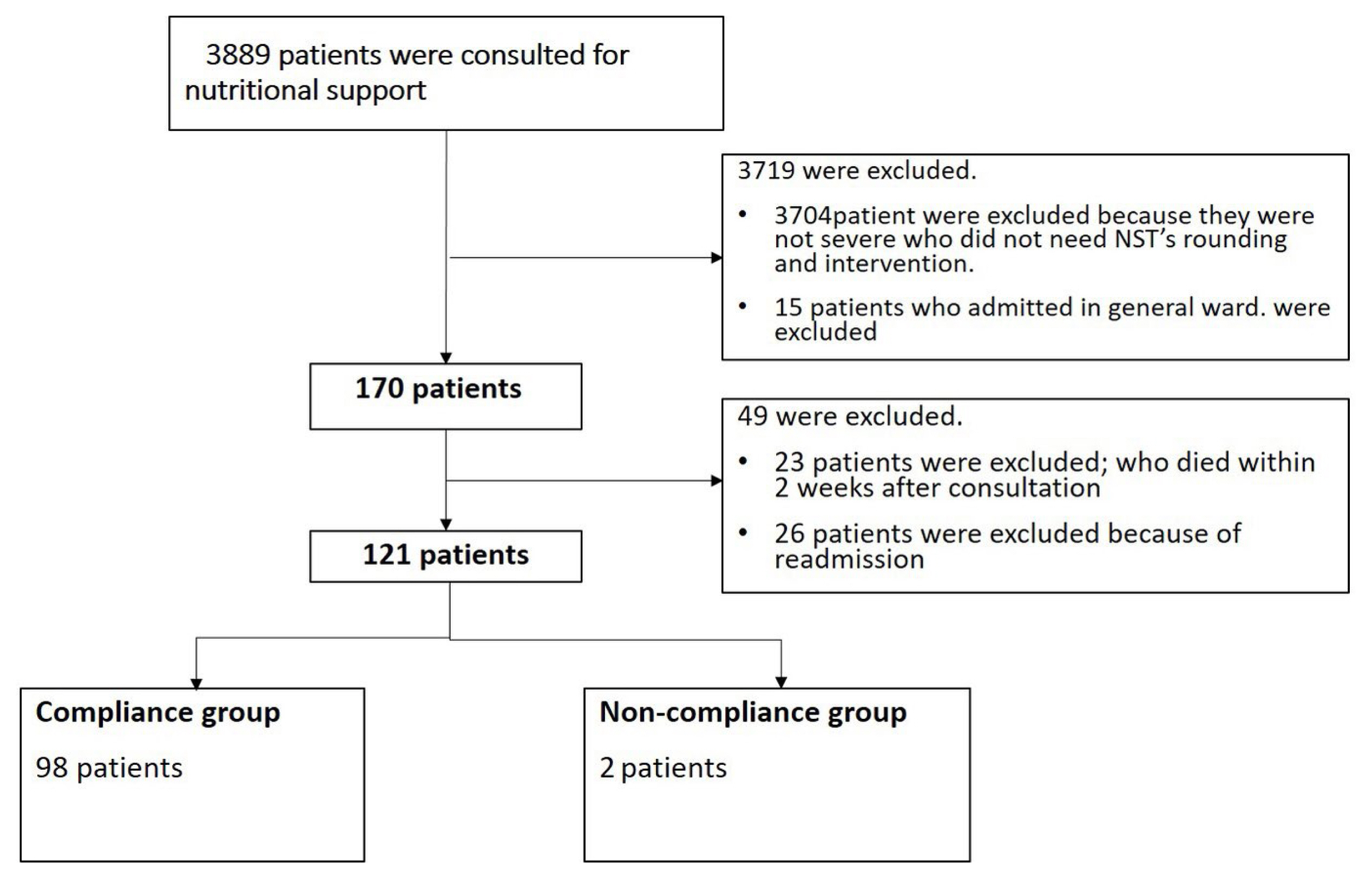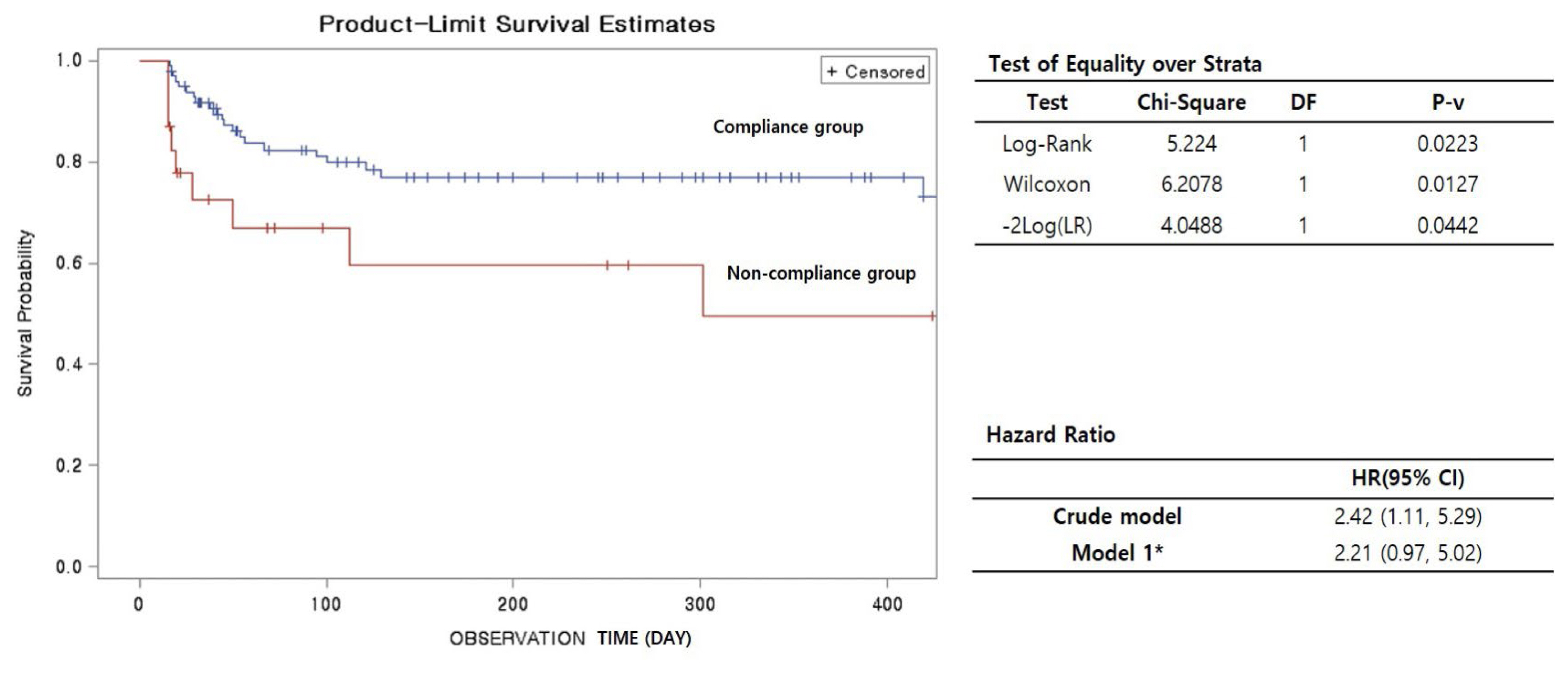1. Lee YM, Kim SH, Kim YS, Kim EM, Kim JY, Keum MA, et al. Nutritional Status of Korean Hospitalized Patients: A Multi-Center Preliminary Survey. J Clin Nutr 2014;6(2):71ŌĆō8.


2. Kreymann KG, Berger MM, Deutz NE, Hiesmayr M, Jolliet P, Kazandjiev G, et al. ESPEN Guidelines on Enteral Nutrition: Intensive care. Clin Nutr 2006;25(2):210ŌĆō23.


3. McClave SA, Taylor BE, Martindale RG, Warren MM, Johnson DR, Braunschweig C, et al. Guidelines for the Provision and Assessment of Nutrition Support Therapy in the Adult Critically Ill Patient: Society of Critical Care Medicine (SCCM) and American Society for Parenteral and Enteral Nutrition (A.S.P.E.N.). JPEN J Parenter Enteral Nutr 2016;40(2):159ŌĆō211.


5. Park KW, Son HR, Ji Hoon Kim MHK, Choi EJ. The effects of early enteral nutrition in patients: a role of nutrition support team. J Clin Nutr 2016;8(2):66ŌĆō70.


6. Swails WS, Samour PQ, Babineau TJ, Bistrian BR. A proposed revision of current ICD-9-CM malnutrition code definitions. J Am Diet Assoc 1996;96(4):370ŌĆō3.


7. Lee HJ, Kim JT, Lee BK. Effects of a Nutrition Support Team with Parenteral Nutrition on Gastrointestinal Cancer Patients Who Underwent Surgery. J Clin Nutr 2014;6(2):79ŌĆō86.


8. Cho JY, Kim JT, Kim SL. Enteral Nutrition Working Group. Survey on the State of Nutrition Support Team (NST) Activity: Comparison of the Questionnaire Survey 2016 vs. 2005 and the State of NST Activity since the Introduction of the Medical Insurance Fee. J Clin Nutr 2016;8(2):38ŌĆō44.


9. Naylor CJ, Griffiths RD, Fernandez RS. Does a multidisciplinary total parenteral nutrition team improve patient outcomes? A systematic review. JPEN J Parenter Enteral Nutr 2004;28(4):251ŌĆō8.


11. Schneider PJ. Nutrition support teams: an evidence-based practice. Nutr Clin Pract 2006;21(1):62ŌĆō7.


12. Traeger SM, Williams GB, Milliren G, Young DS, Fisher M, Haug MT 3rd. Total parenteral nutrition by a nutrition support team: improved quality of care. JPEN J Parenter Enteral Nutr 1986;10(4):408ŌĆō12.


15. Heyland DK, Schroter-Noppe D, Drover JW, Jain M, Keefe L, Dhaliwal R, et al. Nutrition support in the critical care setting: current practice in canadian ICUs-opportunities for improvement? JPEN J Parenter Enteral Nutr 2003;27(1):74ŌĆō83.


16. Kim H, Shin JA, Shin JY, Cho OM. Adequacy of Nutritional Support and Reasons for Underfeeding in Neurosurgical Intensive Care Unit Patients. Asian Nurs Res 2010;4(2):102ŌĆō10.

18. Choi J, Park E. Different Perceptions of Clinical Nutrition Services between Doctors and Dietitians in the Busan-Gyeongnam Area. J Korean Diet Assoc 2013;19(1):69ŌĆō81.

19. Jeong HS, Teong CH, Choi YJ, Kim WJ, Lee AR. Attitudes of Medical Staff and Factors Related to Nutritional Support for Patient Care in a University Hospital. J Clin Nutr 2014;6(1):37ŌĆō41.


20. Seol E, Suh YS, Ju DL, Bae HJ, Lee HJ. Characteristics and Clinical Course of Patients Who Received Enteral or Parenteral Nutrition in Tertiary Referral Hospitals in Korea. J Clin Nutr 2016;8(2):58ŌĆō65.


21. Heyland DK, Cahill N, Day AG. Optimal amount of calories for critically ill patients: depends on how you slice the cake! Crit Care Med 2011;39(12):2619ŌĆō26.


23. De Jonghe B, Appere-De-Vechi C, Fournier M, Tran B, Merrer J, Melchior JC, Outin H. A prospective survey of nutritional support practices in intensive care unit patients: what is prescribed? What is delivered? Crit Care Med 2001;29(1):8ŌĆō12.


24. Krishnan JA, Parce PB, Martinez A, Diette GB, Brower RG. Caloric intake in medical ICU patients: consistency of care with guidelines and relationship to clinical outcomes. Chest 2003;124(1):297ŌĆō305.


25. McClave SA, Codner P, Patel J, Hurt RT, Allen K, Martindale RG. Should We Aim for Full Enteral Feeding in the First Week of Critical Illness? Nutr Clin Pract 2016;31(4):425ŌĆō31.


26. Prittie J, Barton L. Route of nutrient delivery. Clin Tech Small Anim Pract 2004;19(1):6ŌĆō8.


27. Hwang HS, Lee SH, Lee H, Kim KS, Chung SJ, Lee JG. Effects of Nutrition Consultation on Nutritional Status in Critically Ill Surgical Patients. J Clin Nutr 2015;7(1):28ŌĆō34.













